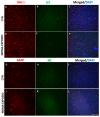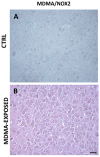Increased iNOS and Nitrosative Stress in Dopaminergic Neurons of MDMA-Exposed Rats
- PMID: 30871034
- PMCID: PMC6429174
- DOI: 10.3390/ijms20051242
Increased iNOS and Nitrosative Stress in Dopaminergic Neurons of MDMA-Exposed Rats
Abstract
Several mechanisms underlying 3,4-Methylenedioxy-N-methylamphetamine (MDMA) neurotoxicity have been proposed, including neurochemical alterations and excitotoxicity mediated by reactive oxygen species (ROS), nitric oxide (NO), and reactive nitrogen species (RNS). However, ROS, NO, and RNS sources in the brain are not fully known. We aimed to investigate possible alterations in the expression of the ROS producer NOX enzymes (NOX2, NOX1, and NOX4), NO generators (iNOS, eNOS, and nNOS), markers of oxidative (8-hydroxy-2'-deoxyguanosine, 8OHdG), and nitrosative (3-nitrotyrosine, NT) stress, as well as the colocalization between cells positive for the dopamine transporter (DT1) and cells expressing the neuronal nuclei (NeuN) marker, in the frontal cortex of rats receiving saline or MDMA, sacrificed 6 h, 16 h, or 24 h after its administration. MDMA did not affect NOX2, NOX1, and NOX4 immunoreactivity, whereas iNOS expression was enhanced. The number of NT-positive cells was increased in MDMA-exposed animals, whereas no differences were detected in 8OHdG expression among experimental groups. MDMA and NT markers colocalized with DT1 positive cells. DT1 immunostaining was found in NeuN-positive stained cells. Virtually no colocalization was observed with microglia and astrocytes. Moreover, MDMA immunostaining was not found in NOX2-positive cells. Our results suggest that iNOS-derived nitrosative stress, but not NOX enzymes, may have a crucial role in the pathogenesis of MDMA-induced neurotoxicity, highlighting the specificity of different enzymatic systems in the development of neuropathological alterations induced by the abuse of this psychoactive compound.
Keywords: MDMA; NADPH oxidases; iNOS; nitrosative stress; oxidative stress.
Conflict of interest statement
The authors declare no conflict of interest.
Figures







Similar articles
-
Melatonin influences NO/NOS pathway and reduces oxidative and nitrosative stress in a model of hypoxic-ischemic brain damage.Nitric Oxide. 2017 Jan 30;62:32-43. doi: 10.1016/j.niox.2016.12.001. Epub 2016 Dec 8. Nitric Oxide. 2017. PMID: 27940344
-
Role of reactive nitrogen and reactive oxygen species against MPTP neurotoxicity in mice.J Neural Transm (Vienna). 2008 Jun;115(6):831-42. doi: 10.1007/s00702-008-0019-6. Epub 2008 Jan 31. J Neural Transm (Vienna). 2008. PMID: 18235988
-
Different oxidative profile and nicotinic receptor interaction of amphetamine and 3,4-methylenedioxy-methamphetamine.Neurochem Int. 2008 Feb;52(3):401-10. doi: 10.1016/j.neuint.2007.07.016. Epub 2007 Jul 28. Neurochem Int. 2008. PMID: 17716785
-
The complex interplay of iron metabolism, reactive oxygen species, and reactive nitrogen species: insights into the potential of various iron therapies to induce oxidative and nitrosative stress.Free Radic Biol Med. 2013 Dec;65:1174-1194. doi: 10.1016/j.freeradbiomed.2013.09.001. Epub 2013 Sep 12. Free Radic Biol Med. 2013. PMID: 24036104 Review.
-
Nitric Oxide-Dependent Pathways as Critical Factors in the Consequences and Recovery after Brain Ischemic Hypoxia.Biomolecules. 2021 Jul 26;11(8):1097. doi: 10.3390/biom11081097. Biomolecules. 2021. PMID: 34439764 Free PMC article. Review.
Cited by
-
Dysfunction of the Neurovascular Unit by Psychostimulant Drugs.Int J Mol Sci. 2023 Oct 13;24(20):15154. doi: 10.3390/ijms242015154. Int J Mol Sci. 2023. PMID: 37894832 Free PMC article. Review.
-
Worsening of the Toxic Effects of (±)Cis-4,4'-DMAR Following Its Co-Administration with (±)Trans-4,4'-DMAR: Neuro-Behavioural, Physiological, Immunohistochemical and Metabolic Studies in Mice.Int J Mol Sci. 2021 Aug 16;22(16):8771. doi: 10.3390/ijms22168771. Int J Mol Sci. 2021. PMID: 34445476 Free PMC article.
-
Brain dysfunctions and neurotoxicity induced by psychostimulants in experimental models and humans: an overview of recent findings.Neural Regen Res. 2024 Sep 1;19(9):1908-1918. doi: 10.4103/1673-5374.390971. Epub 2023 Dec 15. Neural Regen Res. 2024. PMID: 38227515 Free PMC article.
-
Sudden Intrauterine Unexplained Death (SIUD) and Oxidative Stress: Placental Immunohistochemical Markers.Cells. 2024 Aug 13;13(16):1347. doi: 10.3390/cells13161347. Cells. 2024. PMID: 39195237 Free PMC article.
-
Oxidative Stress Markers in Human Brain and Placenta May Reveal the Timing of Hypoxic-Ischemic Injury: Evidence from an Immunohistochemical Study.Int J Mol Sci. 2023 Jul 30;24(15):12221. doi: 10.3390/ijms241512221. Int J Mol Sci. 2023. PMID: 37569597 Free PMC article.
References
MeSH terms
Substances
Grants and funding
LinkOut - more resources
Full Text Sources
Medical
Research Materials
Miscellaneous

